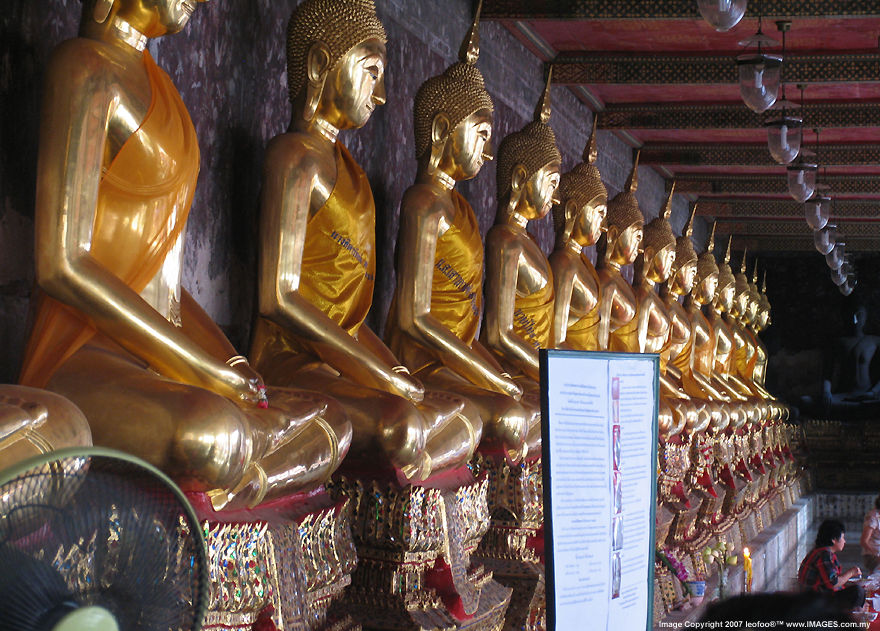 |
There are smaller chapels at four corners built around the Viharn with each hosting
various popular forms and postures of Buddha image such as in reclining from, holding
an alms bowl etc.. Surrounding the main building are 28 multi levels Pagodas which
looks more like Chinese designed style than Thai. There are actually many Chinese
merchants and shops around Wat Suthat and I would possible assume the Chinese community
here had cast their influences in the secondary decor around the temple.
Overall, the Thai Royalties had played a big role in the realization of this beautiful
Buddhist Temple of Wat Suthat Thepwararam.
As King Rama I (King Phutthayotfa Chulalok) was the one who pioneered the idea. King Rama II continued with the project but
he was passed away before it was completed, leaving traces of his attentive attitude
to complete the project . It was during the reign of King Rama III (King Nangklao)
that the temple was finally completed. He was also the one who commanded the casting
of another Buddha Statue Phra
Buddha Trilokachet image now residing at the Phra Ubosot, the Ordination Hall. Incidentally,
King Rama IV (King Monkut) was the King who officially given the name of Phra Buddha
Trilokachet. It was learnt that the extension and completion of other segments in
this whole temple were done during the King Rama V (King Chulalongkorn) reign.
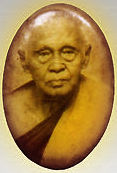 |
Further, there
is a Royal Monument of King Rama VII at the north west section. King Rama VIII actually
had his monkhood at this temple and Abbot
then, Somdej Phra Ariyawongsakotayarn Sakolmaha Sangkhaparinayok (Pae Tissathewo)
was his Buddhist lecturer.
After his death, the present Thai King Bhumibol Adulyadej kept his brother's ashes
of remain under the basement of the Phra Sri Sakayamuni and built a monument outside
the main viharn in remembrance of him.
|
The monument
of King Rama VIII is a life size standing bronze cast figure, fully dressed up as
Commander in Chief. On the 9th of June each year, there are merit making. So, all
these close association between the royal families and Wat Suthat was why sometimes
it was termed as "Phra Vihara Luang" which means The Royal Temple. Technically,
the entire process in the construction of Wat Suthat was stretched from a few generations
of Kings of Thailand, simply based on this fact alone - ain't this a worthy place
for a visit ?
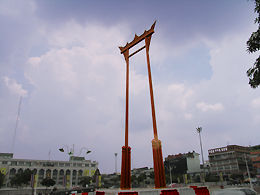 |
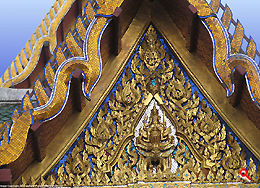 |
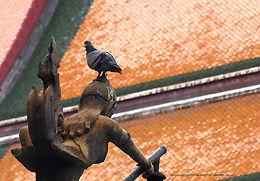 |
|
The giant Swing which was painted in
distinctive red paint is located at one of the main entrance to the temple.
|
The upper pediments at two main sections
have design and architectural design in raw Thai fashion.
|
From roof top, to garden, trees and
branches, there are many sculptures, Buddhist figures being placed around the temple.
|
|
|
 |
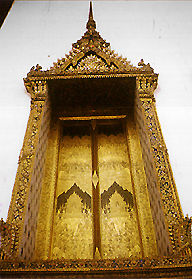 |
Thai public performing their
prayers during the Songkran festival. The temple management permitted worshippers
to bath the Buddha just outside the main viharn. The door shown at left, which reputedly
was designed, hand crafted by the King Rama III himself was protected by plastic
sheets in order to preserve its original state during the festive season of water
festival. This image was a scanned copy.
|
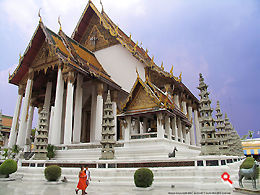 |
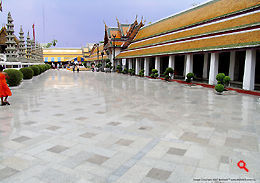 |
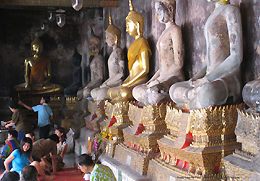 |
|
Rear
section view of the main viharn of Wat Suthat
|
Between
the Main Viharn and surrounding chedi has a very spacious path
|
Each
image at the minor chapel was adopted by family of the deceased.
|
|
| |
| The outer rows of the structure in a
long stretch of an rectangular shape is the smaller chapels has a few hundreds of
Buddha images in same dimension and appearance Those which were placed near the main
entrance are of identical bronze cast colour but a few that located at the rear section
near the ordination hall are in clay formation and some of them are even painted
in black. I was told each of these images has been "adopted" by financially
capable families to host remains of ashes of deceased family members and guarded
here. These smaller metal cast images each measuring approx. 5 feet tall and has
similar posture with the Phra Sri Sakayamuni inside the Viharn. They are neatly and
orderly arranged with each of them arranged in row and facing the main viharn. The
rows of glittering images along with path at the surrounding chapels is one of the
most spectacular scene in and around around the temple compound. During major festival
such as Wesak day or Songkran (It is like the New year for the Thai), family members
usually come to the temple to clean up the adopted images and have gathering around
the adopted image. |
previous
| NEXT | 3/6
Index
Page
| Page
One
| Page
Two
| Page
Three
|
| Page Four- version history of amulets
from Wat Suthat -part I
| Page
Five - version history of Phra Kring from Wat Suthat |
Back to
Main Index Pages of
Thai Buddhist Amulets Section | Interesting Buddhist Landmarks in Asia
Message Board for Questions and
Answers
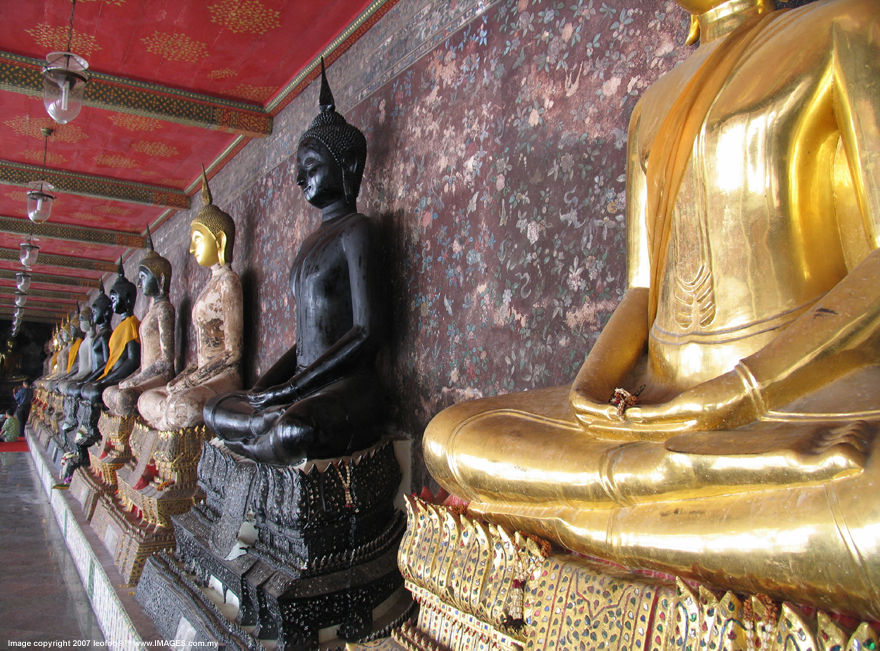
HOME - Photography in Malaysia
This
is NOT an Official Site of Wat Suthat but rather, it serves as a visual journal and
double itself as an introduction to this lovely sacred site. The creator of this
site has no relationship or whatsoever with the Temple and/or its management. Wat
Suthat has an Official Website on their own and any information contain herein in
correctness of content should be referring to the content appeared in their OFFICIAL
SITE.
Terms of Use:- Depending on individual expectation or usage, photos contained
herein may not be regarded as great pictures to some but they are personal visual
collection compiled over years on this specific subject. IF you want to use any of
the images contained herein for personal use, educational purposes and/or promotional
works for our country; by all means USE THEM ! Although a credit is welcomed, but
it is NOT entirely necessary. A link to Official Site of Wat Suthat (in Thai) is always encouraged
. But, If you intend to use and/or attempt to alter original form on any of the images
published in this site for commercial applications, just mail our editors at www.IMAGES.com.my or www.NATURE.com.my to clarify detailed terms of usage (there
are plenty other higher resolution images not published for private viewing). All
or part of the said fees from such possible sale collected will be donated to our
pet project: Khatulistiwa@Malaysia Project.
Copyright ©
1998~2007. leofoo®
MIR Web Development
Team
Credit: To all the good people
who have contributed their own experience, resources or those who are kind enough
in granting us the permission to use their images that appeared on this site. For
materials, I have used some scanned images of the winning entries compiled under
the "Dictionary of Buddha's Small Images" - which is my inspiration and
provides wealth of information to version history. Note: Certain content and images appeared on this
site were taken by using a Canon PowerShot Pro-1 digital camera. Some materials appeared
on this site were scanned from some leaflets, brochures or publications published
by Wat Suthat and/or contribution from surfers who claimed originality of their work
for educational purposes. The creator of the site will not be responsible for any
discrepancies that may arise from such dispute except rectifying.










